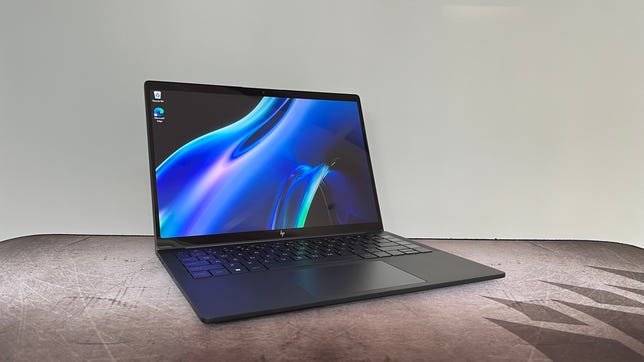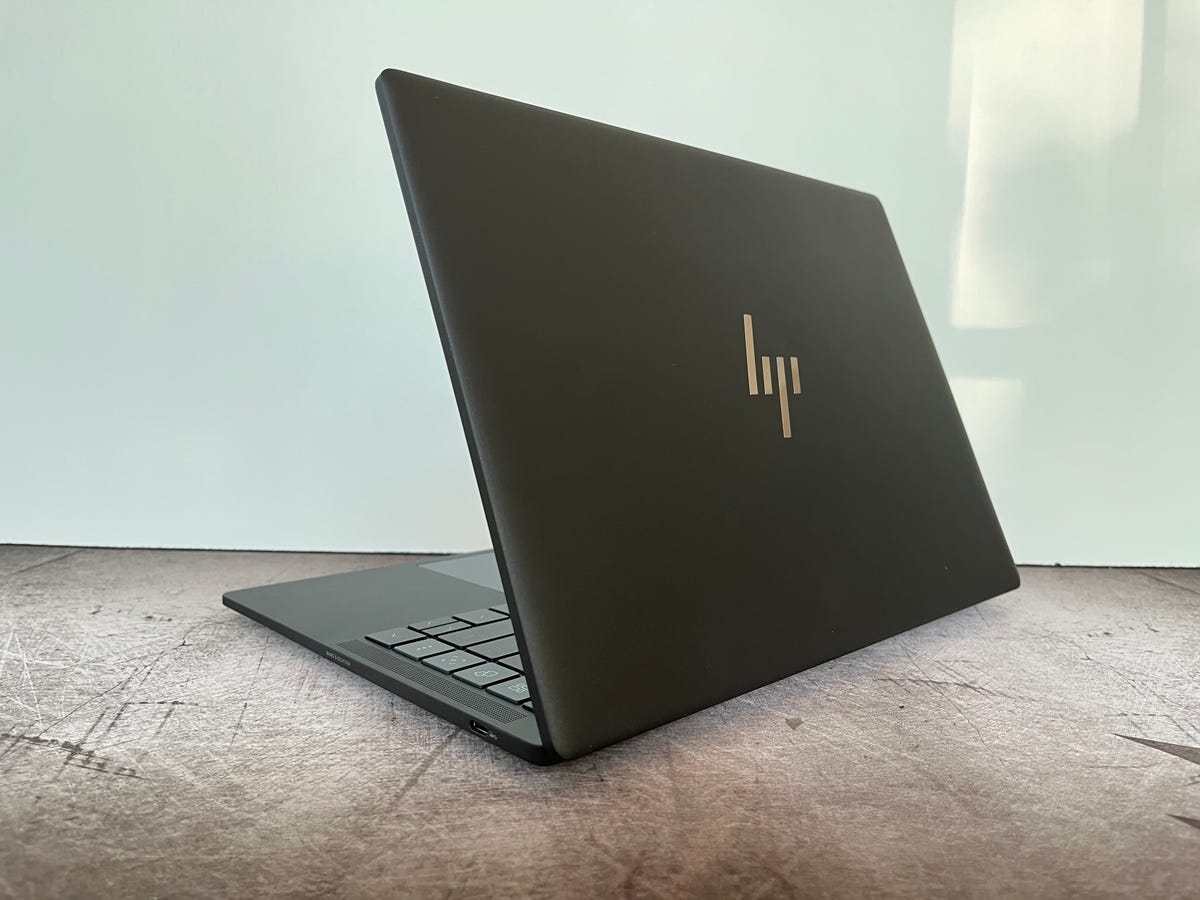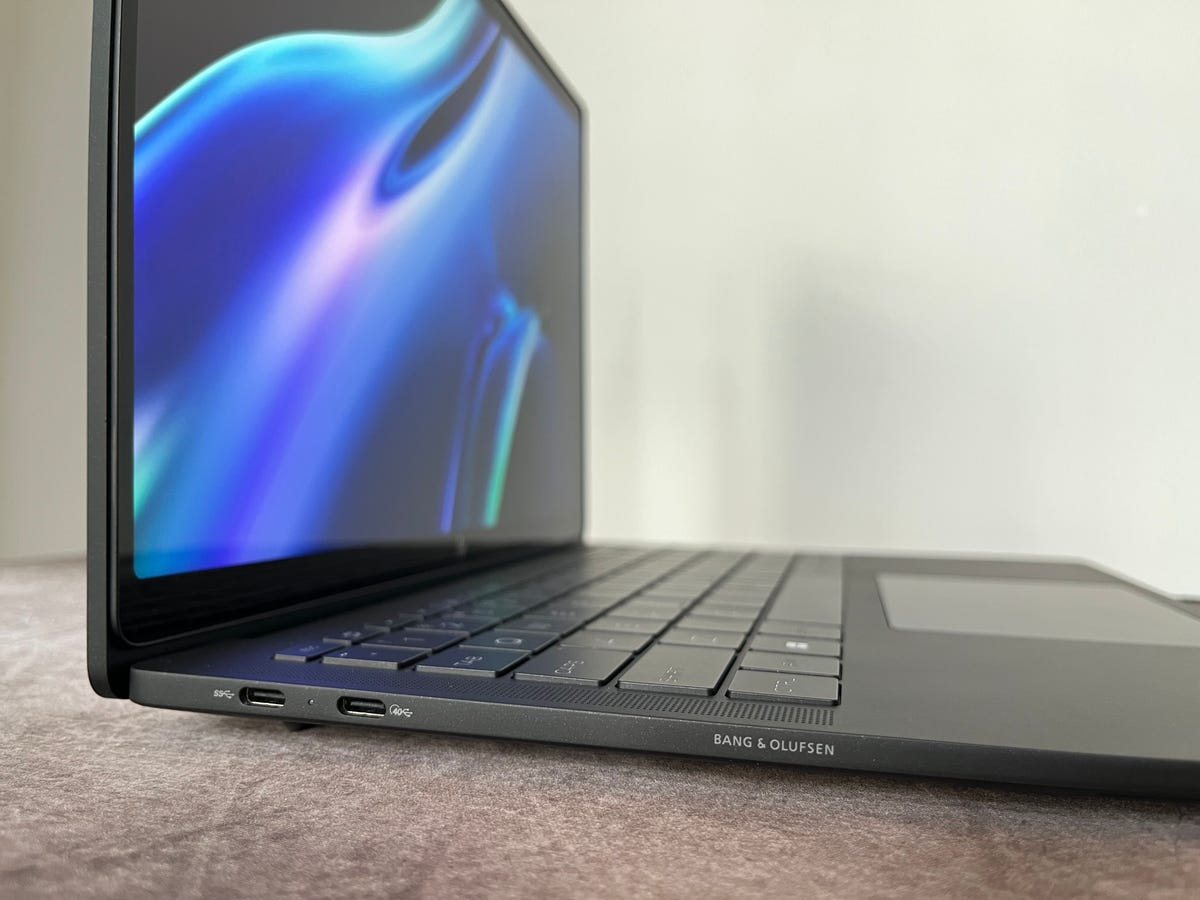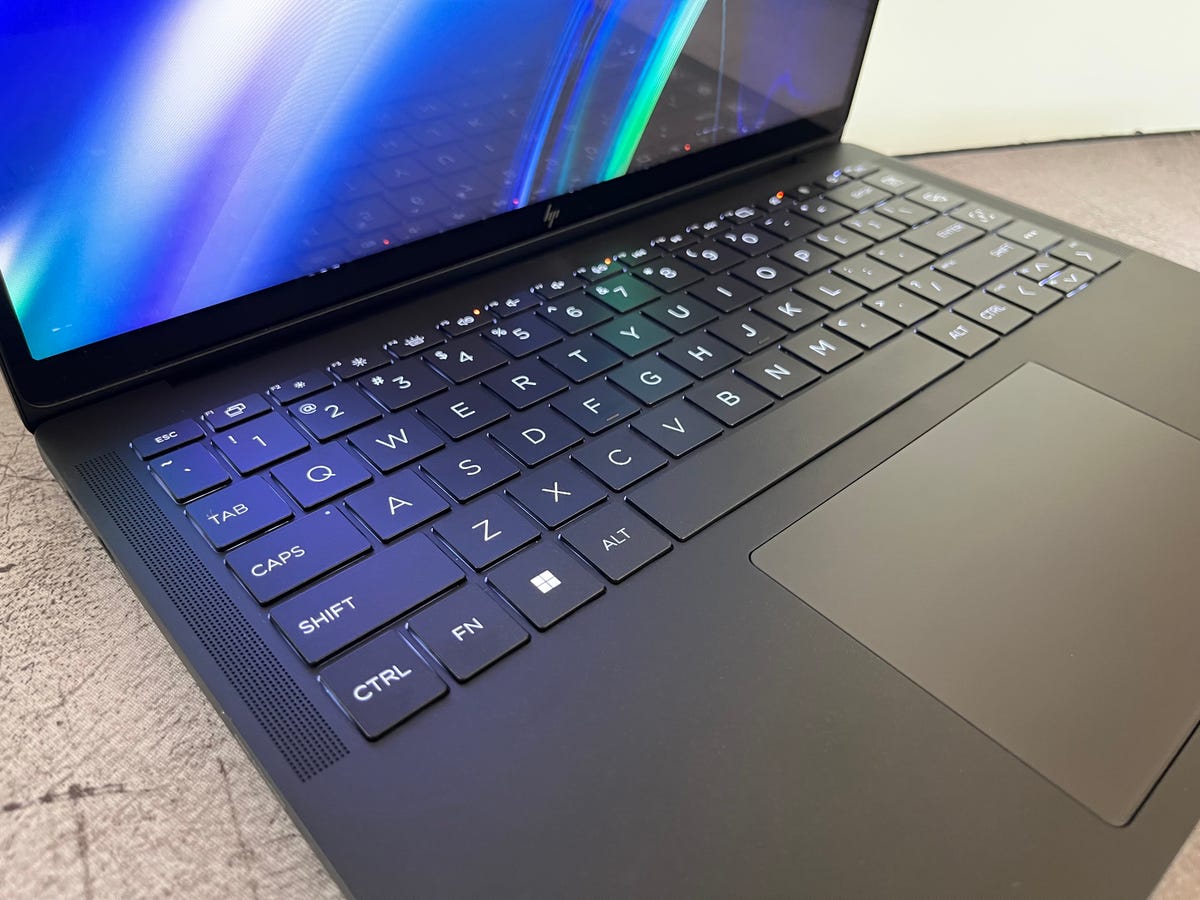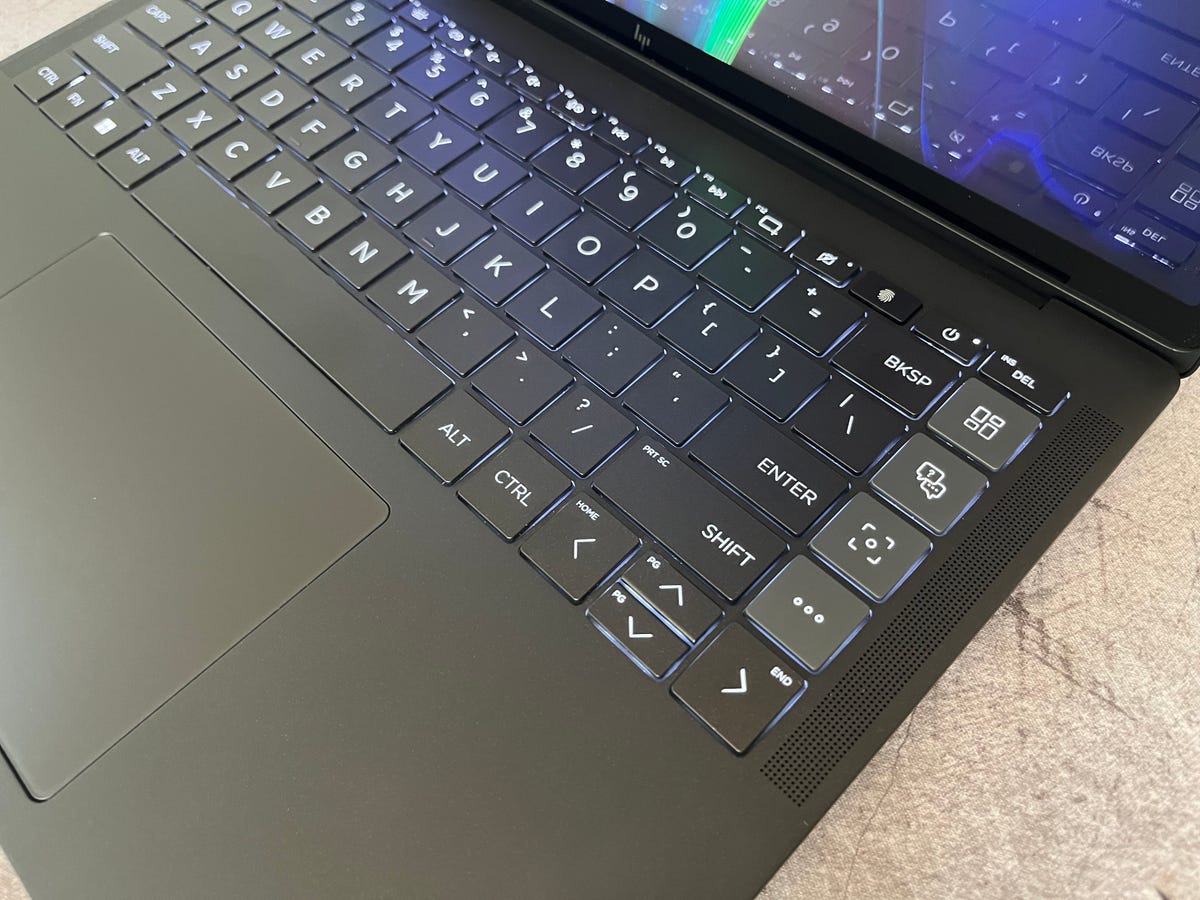HP Dragonfly Pro Review: A Small MacBook Pro for Windows Users
The 14-inch Dragonfly Pro boasts a sleek and sturdy MacBook Pro-like design, but its display is merely adequate and the HP support hotkeys feel gimmicky.
There are plenty of MacBook Pro alternatives, but perhaps none come as close to Apple's minimalist aesthetic as the HP Dragonfly Pro (OK, maybe the Samsung Galaxy Books, too). The Razer Blade 14's slab-like enclosure is a close facsimile to the sleek yet sturdy 14-inch MacBook Pro, but it's geared toward gamers -- an entirely different audience than the MacBook Pro's. The 14-inch Dragonfly Pro boasts a similarly clean and rigid design and targets the same mainstream "pro" users. And priced at a reasonable $1,400, it costs hundreds less than the 14-inch MacBook Pro.
HP designed the Dragonfly Pro for a more narrow audience than simply mainstream laptop users, though. The specific target is on-the-go, constantly connected freelancers and hybrid employees splitting time between home and office. To attract them, HP made a couple of unusual inclusions.
HP dedicated keyboard space for four hotkeys, one of which connects you to HP's 24/7 live support, included for the first year. The other inclusion will likely be more useful to you: a high-res webcam for looking your best during Zoom meetings and the like. Even if you don't use the complimentary concierge support or extend it past the first year, the HP Dragonfly Pro is a great pick for Windows users yearning for a laptop that matches the best that Apple offers.
HP Dragonfly Pro
| Price as reviewed | $1,400 |
|---|---|
| Display size/resolution | 14-inch 1,920x1,200 display |
| CPU | 2.7GHz AMD Ryzen 7 7736U |
| Memory | 16GB DDR5 6,400MHz RAM |
| Graphics | 512MB AMD Radeon Graphics |
| Storage | 512GB M.2 NVMe SSD |
| Ports | 2x Thunderbolt 3, 1x USB 3.2 Gen 1 Type-C |
| Networking | Wi-Fi 6E (802.11ax) (Dual band) 2*2 + Bluetooth 5.2 |
| Operating system | Windows 11 Home |
We reviewed the baseline HP Dragonfly Pro model for $1,400. It features an AMD Ryzen 7 7736U CPU, 16GB of RAM, integrated AMD Radeon Graphics and a 512GB SSD. The step-up model costs $1,550 and doubles the RAM to 32GB and the SSD to 1TB. The only other configurable item is the color: ceramic white or sparkling black; we received the latter. The 14-inch touch display features a 1,920x1,200-pixel with a 16:10 aspect ratio and is rated for 400 nits of brightness.
By the way, there's also a Dragonfly Pro Chromebook. Given the pricing of the Windows 11-based models, it feels overpriced at $1,000 for a Chromebook with a 12th-gen Core i5 CPU, 16GB of RAM and a 256GB SSD. Oddly, the Dragonfly Pro Chromebook has a better display with a 2,560x1,600-pixel resolution and an impressive rated brightness of 1,200 nits.
As configured, our Dragonfly Pro test system produced solid performance results. It finished in the middle of the pack on most of our benchmarks among a group of similarly priced laptops that feature an Intel Core i7-12700H CPU. It lasted roughly 7.5 hours on our demanding battery drain test, another average result. You'll be able to eke out a longer runtime when you aren't constantly streaming a video. In anecdotal testing, the Dragonfly Pro felt peppy, operated quietly and didn't lag during a variety of multitasking scenarios.
In proximity to another Pro
The Dragonfly Pro is a stunner. The chassis is a matte-black thing of beauty. The finish has a soft texture to it that's pleasing to the touch -- it feels like the world's finest-grit sandpaper. Branding, as well as the ports, are kept to a minimum to complete the minimalist expression. HP's funky logo is centered on the lid and again on the center of the bottom screen bezel. Tiny Bang & Olufsen wordmarks sit on each side of the laptop. And that's it for branding. I appreciate the distinct lack of AMD Ryzen CPU and Radeon GPU stickers on the wrist rest.
The aluminum-and-magnesium alloy body feels rigid and sturdy. Like the MacBook Pro, the Dragonfly Pro prioritizes a rock-solid chassis over chasing headlines for being extraordinarily thin and light. That's not to say it's a hulking desktop replacement you can't carry with you. The Dragonfly Pro weighs 3.4 pounds, which is about 1.5 ounces lighter than the MacBook Pro 14. The edges are gently rounded, making it slightly thicker than the 14-inch MacBook Pro: 0.7-inch thick compared to the MacBook Pro 14's 0.6.
The Dragonfly Pro sits on two wide rubber feet on the bottom panel. Between them is a strip of venting that's the only visible venting on the chassis. The wide feet allow for airflow underneath the laptop and also make convenient and comfortable grips with which to carry the laptop.
Apple added some ports back to the latest MacBook Pros after a few iterations of limited connectivity. However, the Dragonfly Pro offers extremely limited connectivity. There are three USB-C ports, and that's it. Two of the ports have Thunderbolt 3 support, and the other is a plain USB Type-C port with a 10Gbps transfer speed. The pair of Thunderbolt 3 ports offer four times the transfer speed. There isn't much of a difference between Thunderbolt 3 and 4 -- both offer 40Gbps speed, but Thunderbolt 3 can support only one 4K display while Thunderbolt 4 can support two. Thunderbolt support on AMD-based laptops is a rarity, however, so at least that's in HP's favor.
What's missing from the port selection? There are no USB-A ports or an Ethernet jack. There's no SD card slot, micro or full-size. And most notably, there's no headphone jack. If your go-to headphones are Bluetooth, then this audio-jack omission isn't a big deal. If you have a wired set, then you'll need to get -- and then not lose -- an adapter, which is always a pain.
The keyboard is a pleasure to use. The keys have a firm response with just the right amount of travel. The stiff magnesium keyboard deck creates a flex-free foundation on which to type. There's two-level backlighting for the keyboard, and helpful LEDs on three of the function keys: the volume-mute key, the microphone-mute key and the webcam kill-switch button. They glow orange when engaged, so you know at a glance when you are muted or have killed the power to the webcam.
Function-row LEDs aside, the big news with the keyboard is the four gray keys along the keyboard's right edge. They open up the MyHP app, where you can access settings and live support. The top button opens up a general settings page in the MyHP app that's not all that useful. The second button opens the support page in MyHP, where you can speak to or chat with a member of the 24/7 Pro Live Support team. The third button opens a page in MyHP where you can adjust audio and video settings for the webcam. The fourth button can be configured to open an application, website, file or folder of your choosing.
I tested the chat feature and asked about the MyHP hotkeys. After taking a minute to create an account, I chatted with a support tech within three minutes, who was cheerful and helpful in outlining the purpose of the four hotkeys.
As satisfying as my encounter with the 24/7 Pro Live Support team was, dedicating four buttons to the cause is overkill. Three of the four keys just open different parts of the MyHP app. Why not just have one button for that? Once you're in the app, it's easy to navigate to the live support and settings pages that each of the buttons takes you to. Plus, I question the need for most people to contact support so regularly it would require a dedicated key. Just a single MyHP hotkey on the function-key row would likely suffice. And then give me the Home, Page-up, Page-down and End keys where the four hotkeys reside.
Adequate display, stellar speakers
The display offers touch support along with sufficient resolution and brightness. While it's true you won't get a touch display with a MacBook (yet), you do get a crisper and brighter display. The Dragonfly Pro's 14-inch, 16:10 display features a 1,920x1,200-pixel resolution and is rated for 400 nits of brightness. I measured its peak brightness with a lux meter to be even a bit higher than its rating, coming in at 450 nits. Still, my 14-inch M1 MacBook Pro measured 500 nits and looked clearly brighter with both machines set to max brightness. The Dragonfly Pro's glossy screen coating also makes whatever you're viewing difficult to see in sunny or otherwise well-lit environments. And the M1 MacBook Pro's 14-inch Liquid Retina XDR display has a much finer 3,024x1,964-pixel resolution.
Images and text look fairly sharp on the Dragonfly Pro's display, but if I had to stare at text all day, I'd much prefer to stare at a MacBook Pro where text looks inky black and smooth. In comparison, the text on the HP looked a bit blurry and pixelated when seated up close to the Dragonfly Pro.
The webcam does not lack for resolution, though. It's a 5-megapixel camera that can capture 1440p video. You'll look your best on video calls -- the image was free of the graininess you get with a typical 720p webcam. And colors and skin tones looked accurate.
Similarly impressive is the audio output. HP outfits the Dragonfly Pro with not two but four speakers, and they produce richer, fuller sound than that of the usual laptop stereo setup. It's actually enjoyable listening to music on the Dragonfly Pro (at least in a small room), something I rarely say about a laptop.
With its sturdy, minimalist chassis, the HP Dragonfly Pro can rightly take a seat at the table of MacBook Pro alternatives. Its display can't match the MacBook Pro's, but its matte-black chassis is every bit as sleek and sturdy as an Apple's. I wish you could bump the display up in resolution a notch or two, and while I like getting a year of dedicated and complimentary support, I certainly don't need four separate buttons to access it. Those quibbles aside, the HP Dragonfly Pro offers a gorgeous design and solid build quality and is about as close as you can get to a 14-inch MacBook Pro in a Windows laptop.
How we test computers
The review process for laptops, desktops, tablets and other computer-like devices consists of two parts: performance testing under controlled conditions in the CNET Labs and extensive hands-on use by our expert reviewers. This includes evaluating a device's aesthetics, ergonomics and features. A final review verdict is a combination of both objective and subjective judgments.
The list of benchmarking software we use changes over time as the devices we test evolve. The most important core tests we're currently running on every compatible computer include: Primate Labs Geekbench 5, Cinebench R23, PCMark 10 and 3DMark Fire Strike Ultra.
Geekbench 5 (multicore)
Cinebench R23 (multicore)
3DMark Wild Life Extreme
Online streaming battery drain test
System configurations
| HP Dragonfly Pro | Microsoft Windows 11 Home; 2.7GHz AMD Ryzen 7 7736U; 16GB DDR5 6,400MHz; 512MB AMD Radeon Graphics; 512GB SSD |
|---|---|
| Asus Vivobook 16X OLED | Microsoft Windows 11 Home; 2.3GHz Intel Core i7-12700H; 16GB DDR4 3,200MHz; 128MB Intel Iris Xe Graphics; 512GB SSD |
| Dell Inspiron 16 Plus 7620 | Microsoft Windows 11 Home; 2.3GHz Intel Core i7-12700H; 16GB DDR5 4,800MHz; 4GB Nvidia RTX 3050 Ti ; 512GB SSD |
| Acer Swift 3 OLED | Microsoft Windows 11 Home; 2.3GHz Intel Core i7-12700H; 16GB DDR5 4,800MHz;128MB Intel Iris Xe Graphics; 1TB SSD |
| HP Pavilion Plus Laptop 14 | Microsoft Windows 11 Pro; 2.3GHz Intel Core i7-12700H; 16GB DDR4 3,200MHz;128MB Intel Iris Xe Graphics; 1TB SSD |


